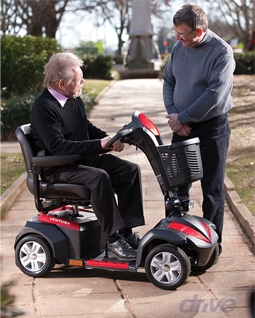"Upcaring": Finding
Additional Business
in Your Own Backyard
REQUEST A
CONSULTATION
Medicare reimbursement regulations mandate that PMD providers execute at least one documented in-home assessment and visit to each client. Many PMD providers view this visit as nothing more than a necessary step in the reimbursement process, and they often schedule it to coincide with delivery of the clients’ PMDs. Following this business protocol is like leaving money on the table. Why? Because not recognizing the in-home visit as the chance to evaluate clients’ needs and identify upselling opportunities for additional products and accessories is like walking away from extra revenue.
Upcaring One Room at a Time
Following is a room-by-room guide to gauging clients' needs during the in-home visit:
Entryway:
Is the residence PMD accessible, or would folding ramps assist the client in entering their home, and/or for traveling? Does the client have any strength or dexterity limitations that could be aided by an interior door opener?
Living Room and Kitchen:
Can the client transfer to their PMD independently or is assistance required with a transfer device? Could they benefit from a reacher device in the kitchen, and/or in any other rooms? Is their dexterity regarding eating limited to the point that they could use a handled cup or bib?
Bedroom:
Do the client's physical limitations necessitate a hospital bed and/or transfer device? If so, does he or she need regular hospital bed sheets, or does severely limited mobility suggest they would benefit from pressure prevention products? Whether in a regular or a hospital bed, would a hospital bed table make the client’s life easier? Would dressing aids, such as a long-handled shoe-horn, dressing stick or stocking aid improve their experience?
Bathroom:
There is a wide variety of bath and commode products to assist clients' specific needs, from different models of shower chairs and benches, grip bars, suction rails and transfer aids to long-handled sponges and wide grip personal care items. Speaking with the client and/or their caregiver and assessing the room itself will clarify which products would benefit each client.
As a PMD provider, your inventory probably consists of far more home medical products than just PMDs, so why not utilize your in-home visit and assessment to see if any other products or accessories could aid each client in their MRADLs and improve the safety of their environment? By doing so, you’ll be “upcaring”: Applying a new, more client-centric business model that allows you to capitalize on your opportunities for upselling products to improve your clients’ quality of life, while building and strengthening the trusted expert provider/client relationship.
Successful upcaring starts with a thorough, documented in-home assessment by providers’ personnel, who should be well-versed in their full line of home medical products and well-trained in how to coordinate their products to their clients’ needs and home environment. The visit and assessment should be scheduled to occur as soon as possible once a client referral is made, and before a PMD is ordered, to take full advantage of the potential for upselling the right products and accessories.

Upcaring the PMD
In addition to evaluating individual rooms and the MRADLs that occur in each, there are upcaring opportunities for features of the PMD itself. Recommending the best PMD, accessorized to meet each client’s individual needs, will minimize non-reimbursable repairs and returns, maximize client satisfaction, and allow you to minimize audit risk by diversifying product codes.
Devote time to speaking in depth with each client and their caregiver(s) during the in-home assessment, and you will get a clear picture of what day-to-day use of their PMD will require. Weight, transportability and dimensions are primary considerations for the optimal PMD, but doing a detailed interview will reveal needs and preferences for other add-ons, such as bag and basket types and cup-holders, upholstery, seat recline and brake operation. Getting a sense of indoor vs. outdoor use will clarify a need for accessories like trailers, sunshades, headlights and mirrors.
Prepare to Upcare
The individuals representing the provider during the in-home visit should be prepared with training and materials to groom them as experts in upcaring. The best provider representatives will have detailed product knowledge of what they have, what it does and how each item could assist clients with their MRADLs. They should be equipped for each visit with product catalogs as well as leave-behind product information to assist clients in additional purchase decisions even after the in-home visit. This is an opportunity to forge a partnership with each client in which they feel comfortable with your recommendations, based on your expertise, and assured that once their products are delivered, they are not on their own to implement them. Commit to ongoing assistance; a visit during or post-product delivery, and an invitation to visit the provider’s retail location, where possible.
Don't Leave Money on the Table...
...by viewing the insurance-mandated visit as a necessary requirement for reimbursement, rather than as a chance to see what your clients need, what they don't currently have and what you can provide. Manufacturers and marketers of most consumer products would give their sizeable research budgets for the chance to get to know their customers firsthand in their own "habitats" and to learn more about their product preferences. The mandatory in-home visit provides smart providers with exactly that chance, opening doors to upselling, upcaring opportunities beyond what you may have previously thought possible.


